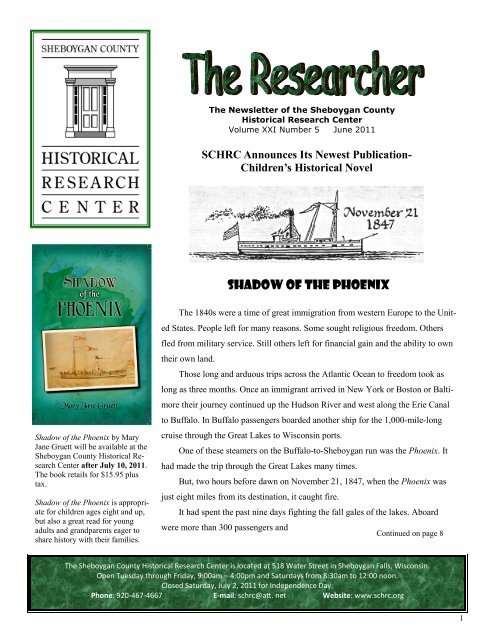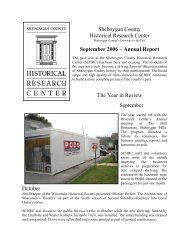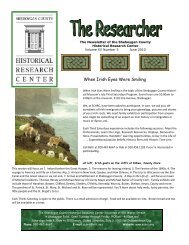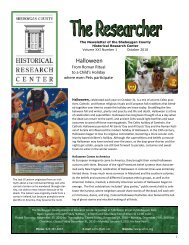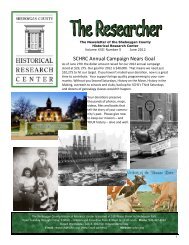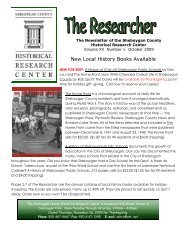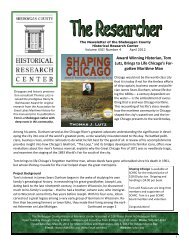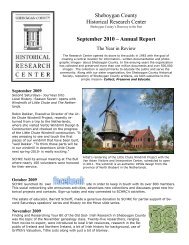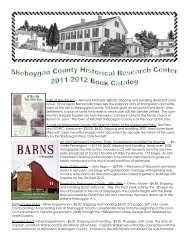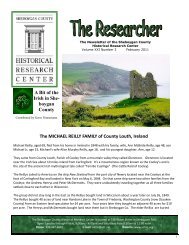Shadow of the Phoenix - Sheboygan County Historical Research ...
Shadow of the Phoenix - Sheboygan County Historical Research ...
Shadow of the Phoenix - Sheboygan County Historical Research ...
Create successful ePaper yourself
Turn your PDF publications into a flip-book with our unique Google optimized e-Paper software.
The Newsletter <strong>of</strong> <strong>the</strong> <strong>Sheboygan</strong> <strong>County</strong><br />
<strong>Historical</strong> <strong>Research</strong> Center<br />
Volume XXI Number 5 June 2011<br />
SCHRC Announces Its Newest Publication-<br />
Children’s <strong>Historical</strong> Novel<br />
<strong>Shadow</strong> <strong>of</strong> <strong>the</strong> <strong>Phoenix</strong><br />
<strong>Shadow</strong> <strong>of</strong> <strong>the</strong> <strong>Phoenix</strong> by Mary<br />
Jane Gruett will be available at <strong>the</strong><br />
<strong>Sheboygan</strong> <strong>County</strong> <strong>Historical</strong> <strong>Research</strong><br />
Center after July 10, 2011.<br />
The book retails for $15.95 plus<br />
tax.<br />
<strong>Shadow</strong> <strong>of</strong> <strong>the</strong> <strong>Phoenix</strong> is appropriate<br />
for children ages eight and up,<br />
but also a great read for young<br />
adults and grandparents eager to<br />
share history with <strong>the</strong>ir families.<br />
The 1840s were a time <strong>of</strong> great immigration from western Europe to <strong>the</strong> United<br />
States. People left for many reasons. Some sought religious freedom. O<strong>the</strong>rs<br />
fled from military service. Still o<strong>the</strong>rs left for financial gain and <strong>the</strong> ability to own<br />
<strong>the</strong>ir own land.<br />
Those long and arduous trips across <strong>the</strong> Atlantic Ocean to freedom took as<br />
long as three months. Once an immigrant arrived in New York or Boston or Baltimore<br />
<strong>the</strong>ir journey continued up <strong>the</strong> Hudson River and west along <strong>the</strong> Erie Canal<br />
to Buffalo. In Buffalo passengers boarded ano<strong>the</strong>r ship for <strong>the</strong> 1,000-mile-long<br />
cruise through <strong>the</strong> Great Lakes to Wisconsin ports.<br />
One <strong>of</strong> <strong>the</strong>se steamers on <strong>the</strong> Buffalo-to-<strong>Sheboygan</strong> run was <strong>the</strong> <strong>Phoenix</strong>. It<br />
had made <strong>the</strong> trip through <strong>the</strong> Great Lakes many times.<br />
But, two hours before dawn on November 21, 1847, when <strong>the</strong> <strong>Phoenix</strong> was<br />
just eight miles from its destination, it caught fire.<br />
It had spent <strong>the</strong> past nine days fighting <strong>the</strong> fall gales <strong>of</strong> <strong>the</strong> lakes. Aboard<br />
were more than 300 passengers and<br />
Continued on page 8<br />
The <strong>Sheboygan</strong> <strong>County</strong> <strong>Historical</strong> <strong>Research</strong> Center is located at 518 Water Street in <strong>Sheboygan</strong> Falls, Wisconsin.<br />
Open Tuesday through Friday, 9:00am – 4:00pm and Saturdays from 8:30am to 12:00 noon.<br />
Closed Saturday, July 2, 2011 for Independence Day.<br />
Phone: 920-467-4667 E-mail: schrc@att. net Website: www.schrc.org<br />
1
The <strong>Research</strong>er is <strong>the</strong><br />
<strong>of</strong>ficial newsletter <strong>of</strong> <strong>the</strong><br />
<strong>Sheboygan</strong> <strong>County</strong> <strong>Historical</strong><br />
<strong>Research</strong> Center.<br />
It is published six times each<br />
year in February, April,<br />
June, August, October and<br />
December.<br />
SCHRC Board <strong>of</strong> Directors<br />
Ron Becker<br />
Transpo Companies<br />
David Gallianetti<br />
Lakeland College<br />
Steven Gallimore<br />
Skana Aluminum<br />
Robert Gorges<br />
Retired Educator<br />
E. Anthony Fessler<br />
Lakeland College<br />
Larshelby „Schel‟ Kidd<br />
The Wine House<br />
Ann McIntyre<br />
Mount Mary College<br />
Angela Miller<br />
Kohler Company<br />
Darlene Navis<br />
Retired Register <strong>of</strong> Deeds<br />
Carl Paul<br />
The Fringe, Raih Tax<br />
Randy Schwoerer<br />
BID Manager <strong>Sheboygan</strong><br />
William Wagner<br />
Retired Physician<br />
Wayne Warnecke<br />
Retired Lakeland College<br />
Sharon Winkle<br />
Mead Public Library<br />
Joe Zagozen<br />
Pharmacist Glander Drug<br />
This image is from 2004 <strong>the</strong> last time The <strong>Research</strong> Center was painted. SCHRC<br />
will again be painted and given a facelift this summer. Work is scheduled to start<br />
on July 5, 2011. Hope for bright, sunny and dry wea<strong>the</strong>r. Look for more changes<br />
to <strong>the</strong> yard.<br />
Thanks to Bob Gorges and Dr. Bill Wagner for <strong>the</strong>ir help in removing shutters and<br />
washing <strong>the</strong> exterior <strong>of</strong> <strong>the</strong> building. It was a huge help in getting <strong>the</strong> building<br />
ready for painting. Sidewalks will be reset and fur<strong>the</strong>r landscaping will be completed.<br />
Stay tuned.<br />
Grants and Gifts to SCHRC<br />
Thank You to Kohler Foundation for project support for <strong>the</strong> Elkhart Lake/Road<br />
America collection.<br />
Thank You to Nancy Leach, longtime member, for her generous<br />
donation in support <strong>of</strong> <strong>the</strong> mission <strong>of</strong> SCHRC.<br />
Memorial Donations were made to SCHRC for:<br />
Bernice Beuchel<br />
Evelyn Harmelink<br />
Bernice Huibregtse<br />
Joyce Schmidt<br />
Robert Spatt<br />
Each <strong>of</strong> <strong>the</strong>se wonderful people made SCHRC a better place. Thank you.<br />
New SCHRC Members<br />
We are pleased to announce <strong>the</strong> newest SCHRC members:<br />
Tom and Mary Butts<br />
Randy and Gerry Schwoerer<br />
Christian Yurk<br />
Bob Anderson<br />
2
New <strong>Research</strong> Options<br />
The following two Web sites have recently been added to<br />
<strong>the</strong> Max Kade Institute's Resources page<br />
(http://mki.wisc.edu/Resources/Links/Links.htm)<br />
and may be <strong>of</strong> interest to you!<br />
German-American Heritage Museum<br />
(http://www.ugac.org/gahm/gahm.html)<br />
An art and multimedia museum located in Washington,<br />
DC, providing permanent and temporary exhibits on German<br />
immigration and migration across <strong>the</strong> Unites States<br />
and on famous German Americans. The Resources page<br />
provides state-by-state links to informative Web sites about<br />
German immigrants, German organizations and landmarks,<br />
German-American business resources, government resources,<br />
student opportunities, and German-language radio<br />
programs.<br />
Gemütlichkeit, Schnitzelbank, and Kitsch: German-<br />
American Caricature in Vintage Postcards<br />
(http://www.libraries.uc.edu/liblog/2010/05/10/newgerman-american-onlineexhibit-on-<strong>the</strong>-arb-webpage/)<br />
The Archives & Rare Books<br />
Library <strong>of</strong> <strong>the</strong> University <strong>of</strong><br />
Cincinnati has added an exhibit<br />
that explores <strong>the</strong> creation<br />
and perpetuation <strong>of</strong> German<br />
American ethnic stereotypes<br />
through cartoon images<br />
found on popular postcards<br />
in <strong>the</strong> 20th century.<br />
More than fifty cards<br />
illustrating a public view <strong>of</strong><br />
a major ethnic group are included<br />
in <strong>the</strong> exhibit, which<br />
can be downloaded as PDF.<br />
A new collection <strong>of</strong> Civil War maps, charts and documents<br />
from <strong>the</strong> National Oceanic and Atmospheric Administration<br />
(NOAA). http://www.nauticalcharts.noaa.gov/<br />
history/CivilWar/<br />
Under <strong>the</strong> auspices <strong>of</strong> <strong>the</strong> NOAA is <strong>the</strong> Office <strong>of</strong> <strong>the</strong> Coast<br />
Survey, which president Thomas Jefferson established in<br />
1807 to produce nautical charts that would provide for maritime<br />
safety, defense and <strong>the</strong> establishment <strong>of</strong> national<br />
boundaries. By <strong>the</strong> start <strong>of</strong> <strong>the</strong> Civil War, <strong>the</strong> Coast Survey<br />
was a leading scientific agency, charting coastlines and<br />
determining land elevations. It still surveys coasts and produces<br />
nautical charts today. In honor <strong>of</strong> <strong>the</strong> 150th anniversary<br />
<strong>of</strong> <strong>the</strong> Civil War in 2011, NOAA has ga<strong>the</strong>red materials<br />
<strong>the</strong> Coast Survey prepared during <strong>the</strong> war years into a<br />
free online collection called Charting a More Perfect Union<br />
The collection, which will help you visualize terrain, ports,<br />
and coasts as <strong>the</strong>y were from 1861 to 1865, includes: 394<br />
maps and nautical charts used for naval campaigns, and<br />
troop movements and battles.<br />
+ + + + + +<br />
Focus on <strong>the</strong> Collection<br />
The Hill Diary– A transcription <strong>of</strong> an original handwritten<br />
document chronicling <strong>the</strong> emigration <strong>of</strong> Charles Henry Hill<br />
and his wife, Jessie Kathleen Appleton Hill. The family left<br />
Scarborough, Yorkshire, England and sailed to <strong>the</strong> United<br />
States in 1907. The family included <strong>the</strong>ir children, Harry,<br />
8, Walter, 6, and Nellie, almost 4.<br />
A typed version <strong>of</strong> this diary was found among <strong>the</strong> papers<br />
<strong>of</strong> Sarah Spratt after her death in <strong>Sheboygan</strong> Falls in <strong>the</strong><br />
earl 1960s. It is believed that Sarah‟s fa<strong>the</strong>r, George Spratt,<br />
was <strong>the</strong> sponsor <strong>of</strong> <strong>the</strong> Hill family in <strong>the</strong>ir quest to relocate<br />
to America. The document covers <strong>the</strong> days between October<br />
23, 1907 through November 4, 1907.<br />
The following is an excerpt from <strong>the</strong> very end <strong>of</strong> <strong>the</strong> Hill<br />
diary– “People say what a fine country America is, but its<br />
not a patch <strong>of</strong> good. Little England with its nice farmhouses<br />
and stockyards, sheepfolds in turnip fields, nice hedges,<br />
game running about and nice turnpike roads. If some <strong>of</strong><br />
<strong>the</strong>se Yankees had to see Scarborough and district <strong>the</strong>y<br />
would think <strong>the</strong>y had got to Heaven...Children are delighted,<br />
but me and wife have something more to think about.<br />
We wonder what our reception among strangers will be and<br />
we are both more dead than alive. I have never had my<br />
trousers or stockings <strong>of</strong>f since we left Liverpool and little<br />
or no sleep for three nights, but <strong>the</strong> longest journey comes<br />
to an end. <strong>Sheboygan</strong> is shouted and we get out....So we<br />
finished our journey on November 4th at 4 p.m. Chicago<br />
time, English time 10 p.m. It having taken us twelve days<br />
nine hours...These notes are no exaggeration just as things<br />
appeared to me. The voyage across <strong>the</strong> sea I enjoyed as far<br />
as enjoyment can go, but <strong>the</strong> Ellis Island business and <strong>the</strong><br />
Immigrant Special train under like conditions I would not<br />
go through again for all United States.”<br />
The Hill diary can be found in <strong>the</strong> General Files– Hill Family.<br />
It was donated to The <strong>Sheboygan</strong> <strong>County</strong> <strong>Historical</strong><br />
<strong>Research</strong> Center in February <strong>of</strong> 1994 by Nancy Hill Leach,<br />
daughter <strong>of</strong> Harry Hill.<br />
June Wish List<br />
Paper Towels<br />
Toilet Paper<br />
8 1/2 x 11 White or Colored Paper<br />
Lysol Wipes<br />
3
Pinehurst Farms<br />
The photo above shows a classic view <strong>of</strong> <strong>the</strong> dairy complex at Pinehurst Farms. At one point <strong>the</strong> dairy had seven barns and seven<br />
houses on 500 acres. The water tower, erected in 1912, stood 125 feet above <strong>the</strong> barns and cows it served. In 1942 it was one <strong>of</strong> <strong>the</strong><br />
biggest contributions to <strong>the</strong> country‟s scrap drive when it was demolished and became 45-tons <strong>of</strong> scrap metal. Photo #231-21<br />
Pinehurst Farms, started in 1838 by David Giddings,<br />
was a model <strong>of</strong> innovation from <strong>the</strong> very beginning. An<br />
article in <strong>the</strong> March 4, 1908 edition <strong>of</strong> <strong>the</strong> <strong>Sheboygan</strong><br />
<strong>County</strong> News states <strong>the</strong> following: “Pine Hurst Farms,<br />
which is situated partly within <strong>the</strong> limits <strong>of</strong> <strong>the</strong> picturesque<br />
village <strong>of</strong> <strong>Sheboygan</strong> Falls and part in <strong>the</strong> town <strong>of</strong> Lima, is<br />
one <strong>of</strong> <strong>the</strong> most beautiful and productive farms in <strong>the</strong><br />
Northwest, consisting <strong>of</strong> over 400 acres, about 200 <strong>of</strong><br />
which is under a state <strong>of</strong> cultivation, 120 in beautiful<br />
woods and <strong>the</strong> balance in natural pasturage, well supplied<br />
with water by <strong>the</strong> Onion River and an abundance <strong>of</strong> natural<br />
springs.”<br />
On November 20, 1912, Harvard Giddings, son <strong>of</strong><br />
David Giddings, sold <strong>the</strong> Giddings Pinehurst Farm to Peter<br />
Reiss, president <strong>of</strong> C. Reiss Coal Company. Pinehurst<br />
Farm became <strong>the</strong> summer home <strong>of</strong> <strong>the</strong> extended Reiss<br />
family. Reiss upgraded <strong>the</strong> buildings and in <strong>the</strong> fall <strong>of</strong><br />
1913 <strong>the</strong> completion <strong>of</strong> <strong>the</strong> new 210-foot long barn was<br />
celebrated with a barn dance hosted by <strong>the</strong> Reiss family.<br />
An article from <strong>the</strong> <strong>Sheboygan</strong> Press in 1913, entitled<br />
Hundreds Enjoy Barn Dance at Pinehurst, documents <strong>the</strong><br />
event. “More than seven hundred were guests <strong>of</strong> Mr. and<br />
Mrs. Peter Reiss at a barn dance at <strong>the</strong>ir country home at<br />
Pinehurst last evening. The affair which will linger with<br />
pleasant memories for a long time, took place in <strong>the</strong> large<br />
barn which is being completed on <strong>the</strong> farm and until one<br />
o‟clock this morning <strong>the</strong> guests enjoyed <strong>the</strong>mselves...For<br />
instance <strong>the</strong>re was one dance where <strong>the</strong> lights were turned<br />
<strong>of</strong>f, and <strong>the</strong> two large automobile lamps furnished <strong>the</strong> light<br />
for <strong>the</strong> dance. This was a novel feature that brought forth<br />
applause from <strong>the</strong> dancers as well as <strong>the</strong> onlookers and <strong>the</strong><br />
orchestra was called upon for several encores before <strong>the</strong><br />
lights were turned on...from eight to nine o‟clock <strong>the</strong> full<br />
<strong>Sheboygan</strong> Concert Band was stationed in <strong>the</strong> south end <strong>of</strong><br />
<strong>the</strong> barn on a raised platform...Looking down a space <strong>of</strong><br />
210 feet on ei<strong>the</strong>r side were strings <strong>of</strong> lights shaded by<br />
leaves <strong>of</strong> tinted paper giving a color that harmonized with<br />
<strong>the</strong> entire decorative scheme. Giant corn stalks toge<strong>the</strong>r<br />
with pumpkins, and sheaths <strong>of</strong> barley comprised <strong>the</strong> decorative<br />
scheme...<strong>the</strong> concert under <strong>the</strong> leadership <strong>of</strong> Henry<br />
Johnson was one <strong>of</strong> <strong>the</strong> treats <strong>of</strong> <strong>the</strong> evening. But <strong>the</strong><br />
grand march, comprised <strong>of</strong> 608 dancers was <strong>the</strong> highlight.”<br />
Peter Reiss enjoyed his farm and summer home for<br />
just fourteen years, passing away on September 5, 1926.<br />
Peter and Mattie had two daughters, Carita who married<br />
Harold Bachmann and Gertrude who married John Corbett.<br />
Both families spent <strong>the</strong>ir summers at Pinehurst.<br />
Mattie Reiss continued <strong>the</strong> operation <strong>of</strong> farm after<br />
Peter‟s death, but in 1930, hired Harry Hill to manage it.<br />
Mr. Hill managed Pinehurst Farms for fourteen years. Hill,<br />
a native <strong>of</strong> Scarborough, England, was widely known in<br />
regional farm circles. He was active in <strong>the</strong> Wisconsin Holstein<br />
Breeders Association and was awarded <strong>the</strong> Wisconsin<br />
Agriculturist gold medal in 1937 as one <strong>of</strong> Wisconsin‟s<br />
five outstanding farmers. Hill left Pinehurst in 1944 for a<br />
position in <strong>the</strong> farm industries‟ division at Curt G. Joa.<br />
4
At this point <strong>the</strong> dairy stopped bottling its own milk,<br />
selling its product to Verifine where it was processed.<br />
Besides <strong>the</strong> cattle, Pinehurst also operated a greenhouse<br />
and continued to raise poultry. In 1948, Mrs. Reiss<br />
donated a part <strong>of</strong> <strong>the</strong> property to <strong>the</strong> city <strong>of</strong> <strong>Sheboygan</strong><br />
Falls to be used as an athletic field.<br />
The following year, <strong>the</strong> summer home, <strong>the</strong> original<br />
Giddings home, a large garage, two poultry houses, a<br />
greenhouse, ten acres <strong>of</strong> virgin pine woods, 180 applebearing<br />
trees and twelve acres <strong>of</strong> garden land comprising<br />
37 1/2 acres was sold to The Christian Home Inc., a nonpr<strong>of</strong>it<br />
organization which took over <strong>the</strong> property for a<br />
home for <strong>the</strong> aged. The corporation represented thirteen<br />
churches in <strong>Sheboygan</strong>, Oostburg, Cedar Grove, <strong>Sheboygan</strong><br />
Falls, Gibbsville and Hingham.<br />
The Giddings home, greenhouse, stable and apple<br />
orchard were sold to private parties. The remaining property<br />
was remodeled into a residence for <strong>the</strong> aging. This<br />
part <strong>of</strong> <strong>the</strong> estate became Pine Haven Christian Home.<br />
In 1950, Mrs. Reiss sold <strong>the</strong> rest <strong>of</strong> Pinehurst Farm<br />
to her grandsons, Peter and David Bachmann. The two<br />
young men operated <strong>the</strong> property toge<strong>the</strong>r until 1955<br />
when Peter sold his share to David.<br />
David Bachmann became known as one <strong>of</strong> <strong>the</strong> bestknown<br />
registered Holstein breeders in Wisconsin. The<br />
prestige and reputation <strong>of</strong> Pinehurst cows brought foreign<br />
buyers on frequent visits to <strong>the</strong> farm and animals were<br />
shipped to all parts <strong>of</strong> <strong>the</strong> world.<br />
Lightning struck between a pair <strong>of</strong> concrete silos <strong>the</strong><br />
evening <strong>of</strong> September 16, 1983, during a severe electrical<br />
storm. The large L-shaped frame barn, a landmark along<br />
State 32, was destroyed by <strong>the</strong> resulting fire. The barn<br />
was immediately rebuilt, but on June 29, 1993 a second<br />
fire demolished <strong>the</strong> barns at Pinehurst. No cause was ever<br />
found. The 1993 fire marked <strong>the</strong> end <strong>of</strong> Pinehurst as a<br />
dairy farm, but began <strong>the</strong> dream <strong>of</strong> a championship golf<br />
course on <strong>the</strong> property. Construction on The Bull golf<br />
course began in <strong>the</strong> summer <strong>of</strong> 2000.<br />
This aerial image, seen below, was taken prior to 1942. It gives a great view <strong>of</strong> <strong>the</strong> entire Pinehurst Farms complex. The signature<br />
dairy barns are at <strong>the</strong> extreme top center. The farm‟s extensive orchards are at <strong>the</strong> bottom <strong>of</strong> <strong>the</strong> photo. Photo #511-51<br />
5
Excerpt from PLOUGHS AMONG THE ESKERS<br />
A story <strong>of</strong> <strong>the</strong> settlement <strong>of</strong> <strong>the</strong> Kettle Moraine<br />
By Bernard Michaels<br />
The Thomas and Mona Scanlan Heraty family standing in front <strong>of</strong> <strong>the</strong>ir cream city brick<br />
home. The homestead was located on <strong>County</strong> Highway V about one-half mile south <strong>of</strong> Hwy<br />
67 in <strong>the</strong> town <strong>of</strong> Mitchell. Heraty was an influential part <strong>of</strong> early immigrant life in <strong>the</strong> area<br />
known as “The Kettles”, acting as an insurance agent, justice-<strong>of</strong>-<strong>the</strong>-peace and postmaster.<br />
The Irish came to <strong>the</strong> Kettles<br />
poorly equipped to begin farming<br />
in <strong>the</strong> wilderness. Land buying<br />
had all but exhausted <strong>the</strong>ir meager<br />
funds and now <strong>the</strong>y were faced<br />
with <strong>the</strong> expense <strong>of</strong> outfitting.<br />
Common to <strong>the</strong> era, equipment<br />
prices were high in <strong>the</strong> frontier<br />
villages. In <strong>Sheboygan</strong> a yoke <strong>of</strong><br />
oxen sold for between fifty-five<br />
and sixty dollars, a wagon brought<br />
fifty-four dollars, cows were sixteen<br />
dollars a head, a plow cost<br />
ten dollars and a harrow, four dollars.<br />
Many settlers walked to <strong>the</strong>ir<br />
Kettle "holdings" carrying little<br />
more than an axe and grub hoe<br />
with which to establish <strong>the</strong>ir new<br />
livelihood.<br />
The first recorded Irish settler<br />
was Dan Murphy who settled on<br />
section 18 in 1846. He was followed<br />
by <strong>the</strong> John O'Reilly family,<br />
lately <strong>of</strong> <strong>County</strong> Meath, who<br />
settled on <strong>the</strong> town line <strong>of</strong> Scott<br />
and Mitchell in <strong>the</strong> fall <strong>of</strong> 1847.<br />
They were joined <strong>the</strong> following<br />
year by Michael and Ann Murray who "took land" east <strong>of</strong> Butler Lake. Within a decade, a hundred families from <strong>the</strong><br />
"Old Sod" had ga<strong>the</strong>red among <strong>the</strong> eskers and kames <strong>of</strong> <strong>the</strong> area. By 1860 those parts <strong>of</strong> Scott, Mitchell, and Osceola<br />
included by today's forest boundaries had become an Irish enclave.<br />
In 1854, <strong>the</strong> settlement built a log church on a small hilltop <strong>of</strong> section twenty-one. The Congregation <strong>of</strong> St.<br />
Michaels was served by a circuit-riding priest until being assigned its first pastor in 1859. The rapid influx <strong>of</strong> Irish settlers<br />
soon gave need for a larger church and in 1861, <strong>the</strong> timber-frame structure serving today's parish was completed.<br />
The wea<strong>the</strong>red inscriptions in <strong>the</strong> churchyard cemetery provide <strong>the</strong> origin <strong>of</strong> many <strong>of</strong> its early members. While <strong>the</strong> Gaelic<br />
place-names represent all corners <strong>of</strong> Ireland, most are from <strong>the</strong> counties west <strong>of</strong> <strong>the</strong> River Shannon, <strong>the</strong> region affected<br />
most severely by <strong>the</strong> famine.<br />
Although many <strong>of</strong> <strong>the</strong> Irish migrated to <strong>the</strong> Kettles in family sized units, two mass arrivals to <strong>the</strong> region also occurred<br />
during <strong>the</strong> 1850s. One <strong>of</strong> <strong>the</strong>se was a group <strong>of</strong> fifteen families from New York state who had been previously<br />
engaged in digging canals in that area. Settling on adjacent holdings along <strong>the</strong> east shore <strong>of</strong> Long Lake, <strong>the</strong>y included<br />
such names as Quinn, Franey and Gilboy. In 1857, a crew <strong>of</strong> Irish laborers, with <strong>the</strong>ir families, was brought into <strong>the</strong><br />
nor<strong>the</strong>rn Kettles to build <strong>the</strong> <strong>Sheboygan</strong>-Mississippi Railroad. When rail construction was temporarily halted for a year,<br />
<strong>the</strong> workers were forced to turn to <strong>the</strong> land for survival, some finding work with farmers, o<strong>the</strong>rs buying land <strong>of</strong> <strong>the</strong>ir<br />
own. Later when <strong>the</strong> railroad was finally completed, many <strong>of</strong> <strong>the</strong>se people remained in <strong>the</strong> community.<br />
The Irish immigrants brought to <strong>the</strong> community <strong>the</strong>ir love <strong>of</strong> social ga<strong>the</strong>rings, music, dancing and just plain<br />
"visiting" which even <strong>the</strong> tragedy <strong>of</strong> <strong>the</strong> famine had not diminished. More than any o<strong>the</strong>rs <strong>the</strong>y showed a preference for<br />
working in groups. As settlers in <strong>the</strong> moraine area, <strong>the</strong>y raised <strong>the</strong>ir buildings, cleared <strong>the</strong> land and picked <strong>the</strong> everpresent<br />
stones with <strong>the</strong> help <strong>of</strong> <strong>the</strong>ir neighbors. These community work ga<strong>the</strong>rings <strong>of</strong>ten numbered scores <strong>of</strong> men, many<br />
6
accompanied by <strong>the</strong>ir womenfolk, who helped in <strong>the</strong> preparation <strong>of</strong> <strong>the</strong> banquet-like meals served that day. Almost<br />
always <strong>the</strong>se events were "capped <strong>of</strong>f" in <strong>the</strong> evening with music and dancing. An entry in Tom Heraty's diary on June<br />
7th, 1871 relates <strong>of</strong> a stoning bee, totaling sixty men and fifteen teams, held on his farm. Ten acres <strong>of</strong> rock-covered<br />
land were cleared that day, and in Heraty's words, "all had a splendid dance in <strong>the</strong> barn that evening".<br />
The Church, during <strong>the</strong> second half <strong>of</strong> <strong>the</strong> nineteenth century, held a firm stance against all Saturday night parties<br />
and dances. This position <strong>of</strong>ten placed <strong>the</strong> socially-minded Irish at odds with <strong>the</strong>ir ecclesiastics. Rev. Bernard Burke,<br />
pastor <strong>of</strong> St. Michaels for nearly twenty years, though a popular priest was a strict interpreter <strong>of</strong> church regulation.<br />
Older citizens <strong>of</strong> <strong>the</strong> locality used to enjoy telling <strong>of</strong> his appearance at <strong>the</strong> scene <strong>of</strong> <strong>the</strong>se unapproved ga<strong>the</strong>rings, (<strong>of</strong>ten<br />
with buggy whip in hand) to admonish his parishioners and send <strong>the</strong>m on <strong>the</strong>ir way.<br />
In <strong>the</strong> accounts <strong>of</strong> local history, much has been presented on <strong>the</strong> male settler and his achievements, while little<br />
space has been given to <strong>the</strong> women. After reading <strong>the</strong> sixty-year journal <strong>of</strong> Thomas Heraty, local Irish-American settler,<br />
it would seem his wife's story, hidden as it is in its pages, deserves some recognition.<br />
Eighteen-year old Mary Ann Scanlon, became <strong>the</strong> wife <strong>of</strong> Mr. Heraty on May 24th, 1865. The bridegroom, a native<br />
<strong>of</strong> <strong>County</strong> Mayo (townland <strong>of</strong> Doon, parish <strong>of</strong> Aughagower) had settled among <strong>the</strong> Mitchell kames in 1852. Mary,<br />
known to her family as Mona, was born in <strong>the</strong> eastern United States shortly after her parents‟ arrival from Ireland.<br />
Now as a newlywed she moved to her husband's homestead to accept <strong>the</strong> duties and responsibilities <strong>of</strong> a settler's wife.<br />
Besides cooking and cleaning, Mona soon found <strong>the</strong>y included; gardening, poultry tending, soapmaking, spinning yarn,<br />
churning butter, caring for elderly in-laws, and doing errands with <strong>the</strong> team and wagon. When <strong>the</strong> men worked late at<br />
<strong>the</strong> family sawmill, she also milked <strong>the</strong> cows.<br />
As <strong>the</strong> years passed, Mona Heraty's skill as midwife and nurse became more evident. She grew accustomed to<br />
being called to area homes at any time <strong>of</strong> day or night, where she might assist in <strong>the</strong> delivery <strong>of</strong> new life at one residence<br />
and provide comfort to <strong>the</strong> dying at yet ano<strong>the</strong>r. When death made a not infrequent visit to <strong>the</strong> neighborhood she<br />
was <strong>the</strong>re to console <strong>the</strong> survivors and help with <strong>the</strong> preparations for <strong>the</strong> two-day wake and burial.<br />
Although she gave birth to thirteen children, seven <strong>of</strong> <strong>the</strong>m would die at an early age. The worst moments <strong>of</strong><br />
Mona's life would always be <strong>of</strong> that terrible January <strong>of</strong> "85" when<br />
three <strong>of</strong> her beloved died <strong>of</strong> diph<strong>the</strong>ria in one week, two slipping<br />
away in her arms within a single hour.<br />
In time, Heraty built a grand, yellow-brick house for his wife,<br />
placing it near <strong>the</strong> road at <strong>the</strong> base <strong>of</strong> a maple covered hill. On <strong>the</strong><br />
morning <strong>of</strong> April 6, 1914, in her sixty-sixth year, Mary Ann Heraty<br />
announced at <strong>the</strong> family breakfast table, her intentions to tap <strong>the</strong> trees<br />
behind <strong>the</strong> house. Leaving shortly with <strong>the</strong> team and wagon, she returned<br />
to <strong>the</strong> farm in a few hours with eighty-five sap buckets. By <strong>the</strong><br />
end <strong>of</strong> <strong>the</strong> next day all were hanging on spiles along <strong>the</strong> tree-covered<br />
slope. Unfortunately her husband's journal fails to mention <strong>the</strong><br />
amount <strong>of</strong> syrup boiled down by Mona that season.<br />
Today, all evidence <strong>of</strong> <strong>the</strong> farm, sawmill and yellow brick house<br />
are gone from <strong>the</strong> northwest quarter <strong>of</strong> section eight. Only <strong>the</strong> rounded<br />
knoll remains with a dozen gnarled maple still clinging to its sides.<br />
Two miles to <strong>the</strong> sou<strong>the</strong>ast in <strong>the</strong> family plot at St. Michaels, Mrs.<br />
Thomas Heraty is finally at rest.<br />
In his day, Thomas Heraty was a pillar <strong>of</strong> <strong>the</strong> community; farmer,<br />
schoolmaster, sawyer, postmaster, writer, and politician, his name was<br />
familiar to those from <strong>Sheboygan</strong> to Fond du Lac. His wife on <strong>the</strong><br />
o<strong>the</strong>r hand, was known only in her neighborhood.<br />
Cemetery and round tower in <strong>the</strong> parish cemetery at Aghagower.<br />
7
RESEARCH CENTER<br />
518 WATER STREET<br />
SHEBOYGAN FALLS, 53085-1455<br />
NON-PROFIT ORGANIZA-<br />
TION<br />
U.S. POSTAGE PAID<br />
PERMIT #19<br />
SHEBOYGAN FALLS, WI 53085<br />
RETURN SERVICE REQUESTED<br />
crew, many immigrants from The Ne<strong>the</strong>rlands. When all was<br />
said and done, more than 250 people perished in <strong>the</strong> disaster.<br />
The <strong>Phoenix</strong> ordeal is well-documented. The <strong>Sheboygan</strong><br />
<strong>County</strong> <strong>Historical</strong> <strong>Research</strong> Center has detailed files.<br />
A number <strong>of</strong> great publications document this story. Two <strong>of</strong><br />
<strong>the</strong>m are: <strong>Phoenix</strong>, The Fateful Journey by John Textor and<br />
Out <strong>of</strong> <strong>the</strong> <strong>Phoenix</strong> by Descendants <strong>of</strong> <strong>the</strong> <strong>Phoenix</strong>.<br />
This historical novel by Mary Jane Gruett tells <strong>the</strong> story<br />
<strong>of</strong> a surviving child <strong>of</strong> <strong>the</strong> disaster in realistic terms <strong>of</strong> <strong>the</strong><br />
era. Though difficult at times, Derk Van Vliet, a young lad<br />
from Winterswijk, Gelderland, The Ne<strong>the</strong>rlands survives and<br />
begins a new life in America.<br />
Local artist Jenna DeTroye contributed three drawings<br />
for <strong>the</strong> book.<br />
Get a copy <strong>of</strong> <strong>Shadow</strong> <strong>of</strong> <strong>the</strong> <strong>Phoenix</strong>, and share this<br />
piece <strong>of</strong> local history with your family!<br />
8


